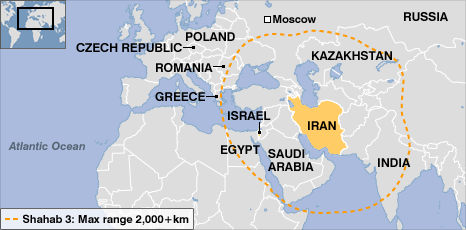http://blogs.law.harvard.edu/mesh/2008/07/media_mapping_of_iran_missile_range/
From MESH Admin
This week, Iranian television showed missile test launches that included a new version of the Shahab-3 missile, which Tehran claims can travel 2,000 kilometers, or 1,250 miles. Various media outlets accompanied this news with maps showing the range of the Shahab-3. An interesting variation in these maps involves just how much of Europe (Russia excluded) is included within that range, and how much emphasis is given to Israel.
• This map, from the BBC, shows Iran’s missile range covering the eastern edge of Europe, and specifically names Greece and Romania as falling within that range. The context of this map is a story on U.S. efforts to establish a missile defense regime for Europe, and so it specifically names potential U.S. partners Poland and the Czech Republic. It also shows one city, Moscow, capital of Russia, which opposes the U.S. plan. Israel is shown but not emphasized. The map implies the U.S. view that Iran’s capabilities are a European problem, and perhaps should be a Russian one too.
• This map, from the New York Times, shows the most extensive coverage of Europe, specifically naming Greece and Ukraine and showing their entire territory within range. Israel is not singled out.
• This map, from Agence France-Presse, includes somewhat less of Europe in Iran’s range, and does not name any European country. Israel is emphasized.
• This Los Angeles Times map does not show any part of Europe within missile range of Iran, not even the small part of Turkey in Europe. The map highlights Israel in bold. The message: It’s Israel vs. Iran.
• This London Guardian map includes a sliver of Europe and Ukraine is named, but the emphasis is clearly on Israel.








